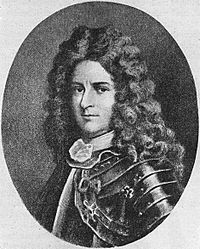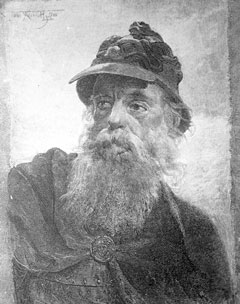Siege of Pemaquid (1696) facts for kids
Quick facts for kids Siege of Pemaquid |
|||||||
|---|---|---|---|---|---|---|---|
| Part of King William's War | |||||||
 Pierre Le Moyne d'Iberville |
|||||||
|
|||||||
| Belligerents | |||||||
| Commanders and leaders | |||||||
|
Pasco Chubb | ||||||
| Strength | |||||||
| Some Marines, 100 Canadiens, 400 Abenaki (50 Mi'kmaq) | 93 New England troops | ||||||
| Casualties and losses | |||||||
| unknown | unknown | ||||||
The Siege of Pemaquid was an important battle during a time called King William's War. It happened when French and Native American forces from New France attacked an English settlement named Pemaquid. Today, this place is known as Bristol, Maine. It was located right on the border with Acadia, another French colony.
The attack was led by a French commander named Pierre Le Moyne d'Iberville and a Native American leader, Baron de St Castin. The siege took place on August 14–15, 1696. Captain Pasco Chubb, who was in charge of Fort William Henry at Pemaquid, surrendered the fort. After the surrender, Iberville sent 92 English soldiers back to Boston.
This victory at Pemaquid was one of the biggest successes for the French during the war. After this siege, the New England forces launched a counter-attack on Acadia.
Contents
Why Pemaquid Was Important
For a long time in the 1600s, Pemaquid (which is now Bristol, Maine) was the most northern English settlement along the coast of New England. At the same time, Pentagouet (now Castine, Maine) was the most southern settlement of Acadia, a French colony.
During King William's War, this area became a major battleground. Both the French and the English wanted to control these lands. They were fighting to decide where their empires would end.
In 1689, Baron de St Castin and the Wabanaki Confederacy (a group of Native American tribes, including the Abenaki) attacked Pemaquid. They captured and burned down the wooden fort there, which was called Fort Charles.
Building a Stronger Fort
By 1692, the English had taken back control of the area. Sir William Phipps ordered a new, stronger fort to be built. This new fort, also called Fort William Henry, replaced the older Fort Charles.
The English built Fort William Henry to protect the northern border of New England. It was the largest fort in New England at the time. The government of Massachusetts spent a lot of money on it, about one-third of its entire budget!
The fort was made of stone and mortar. Its walls were very thick, about six feet wide, and rose ten to twenty feet high. It had eighteen cannons ready to fire from its gun ports. Captain John March helped oversee the rebuilding, with help from Benjamin Church.
A Dangerous Commander
Captain Pasco Chubb was the commander of the new Fort William Henry. He did something very wrong during a meeting held under a flag of truce. He killed several Abenaki chiefs who were there, including Chief Aspinquid.
Because of this, D'Iberville knew he would need both cannons on land and warships to capture the fort. The Abenaki Nation, led by Saint-Castin, decided to join forces with D'Iberville at Pentagouet.
The Attack on Fort William Henry
On August 14, D'Iberville led a large force of 500 fighters to attack Fort William Henry. Five hundred Native American warriors arrived in their canoes and surrounded the fort. This trapped the English soldiers inside.
This clever plan allowed D'Iberville to bring his three French ships into the harbor. He then unloaded his cannons. The French ships immediately began to bombard the fort. Captain Chubb, the English commander, at first refused to give up.
The attack continued until the afternoon of the next day. Finally, Captain Chubb agreed to surrender. He arranged for his men to be taken safely to Boston. There, they would be exchanged for French and Native American prisoners.
What Happened Next
After their victory at Pemaquid, D'Iberville and the Native American forces continued their attacks. They moved on to the English colony of Newfoundland. They raided many villages there during what was called the Avalon Peninsula Campaign.
Major Church, an English leader, got revenge for the siege. He went to Acadia and led the Raid on Chignecto.
Sadly, Captain Chubb, who surrendered the fort, was later found by Native Americans two years later. He was attacked in his home in Andover, along with his family.


